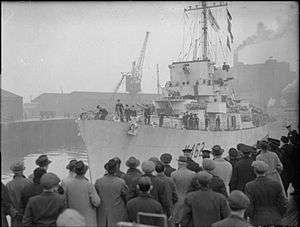HMS Affleck (K462)
 | |
| History | |
|---|---|
| Laid down: | 5 April 1943 |
| Launched: | 30 June 1943 |
| Out of service: | Assigned to the Royal Navy June 1943. |
| Reinstated: | Returned August 1945. |
| Fate: | Sold into mercantile service 24 January 1947. |
| History | |
| Commissioned: | 29 September 1943 |
| Out of service: | Returned to the United States Navy in August 1945 |
| General characteristics | |
| Displacement: | 1,800 tons fully loaded |
| Length: | 306 ft (93 m) overall |
| Beam: | 36.5 ft (11.1 m) |
| Draught: | 11 ft (3.4 m) fully loaded |
| Speed: | 24 knots (44 km/h) |
| Endurance: | 5,500 nautical miles (10,190 km) at 15 knots (28 km/h) |
| Complement: | Typically between 170 & 180 |
HMS Affleck was a Captain class frigate which served during World War II. The ship was named after Sir Edmund Affleck, commander of HMS Bedford at the Moonlight Battle in 1780 during the American Revolutionary War.
Originally destined for the US Navy as a Buckley-class destroyer escort, HMS Affleck was provisionally given the name USS Oswald (later this name was reassigned to DE-767). However, the delivery was diverted to the Royal Navy before the launch.
Commanding Officers were Lt E I Pilditch on commissioning, then Cdr C Gwinner RN (Senior Officer 1st Escort Group).
Actions
HMS Affleck served exclusively with the 1st Escort Group taking part in operations in the North Atlantic, off Normandy, and in the English Channel.
On 19 February 1944, together with HMS Bentley, HMS Affleck picked up 54 survivors from the Panamanian merchant Colin which had been torpedoed and sunk the previous day in the North Atlantic in position 54°16′N 31°58′W / 54.267°N 31.967°W by the German submarine U-859.
On 26 February 1944 in the North Atlantic at position 49°45′N 26°20′W / 49.750°N 26.333°W HMS Affleck, together with HMS Gore and HMS Gould, sank U-91 by the use of depth charges and then by use of main guns. When the damaged uboat surfaced and tried to ram HMS Affleck, this action resulted in 36 dead and 16 survivors from U-91's crew.
On 1 March 1944 in the Northern Atlantic north of the Azores at position 45°46′N 23°16′W / 45.767°N 23.267°W HMS Affleck together with HMS Gore, HMS Gould and HMS Garlies sank U-358 by the use of depth charges, resulting in 50 dead and 1 survivor from the submarine's crew.
On 16 March 1944 in the Straits of Gibraltar at position 35°55′N 05°41′W / 35.917°N 5.683°W HMS Affleck together with the destroyer HMS Vanoc and three US Catalina aircraft (VP 63) sank U-392 by the use of a hedgehog attack, resulting in 52 dead (all hands) from U-392's crew.
On 25 June 1944 HMS Affleck with HMS Balfour attacked a submarine believed to be U-1191 by the use of depth charges, this resulted in the sinking of the submarine with the loss of all hands. This action took place 25 nautical miles (46 km) south of Start Point. The Kriegsmarine had U-1191 listed as missing (no radio contact) since 12 June 1944.[1]
On 26 December 1944 at 14:14 off the French coast near Cherbourg, U-486 launched three acoustic torpedoes at the 1st Escort Group hitting Affleck and HMS Capel. This resulted in the sinking of Capel.Affleck was towed to port, where the ship was written off as a Constructive Total Loss.
Return to United States Navy
Affleck was returned to the US Navy in August 1945 in Britain, where she was sold on 24 January 1947 to the Lisbon-based Transcontinental Victory Commercial Corporation Ltd. She was renamed Nostra De La Luz and survived as a hulk until the 1970s.[2]
General information
- Pennant (UK): K 462
- Pennant (US): DE 71
- Built by: Bethlehem-Hingham Shipyard Inc. (Hingham, Massachusetts, U.S.A.)
References
- ↑
- Innes McCartney (2002). Lost Patrols: Submarine Wrecks of the English Channel.
- ↑ "HMS Affleck". uboat.net. Retrieved 24 May 2018.
- The Captain Class Frigates in the Second World War by Donald Collingwood. published by Leo Cooper (1998), ISBN 0-85052-615-9.
- The Buckley-Class Destroyer Escorts by Bruce Hampton Franklin, published by Chatham Publishing (1999), ISBN 1-86176-118-X.
- German U-Boat Losses During World War II by Axel Niestle, published by United States Naval Inst (1998), ISBN 1-55750-641-8.
This article incorporates text from the public domain Dictionary of American Naval Fighting Ships. The entries can be found here and here.
External links
- Uboat.net page for HMS Affleck
- Uboat.net page for U-859
- Uboat.net page for U-91
- Uboat.net page for U-358
- Uboat.net page for U-392
- Uboat.net page for U-1191
- Uboat.net page for U-486
- captainclassfrigates.co.uk
- The Gazette 26th June 1945